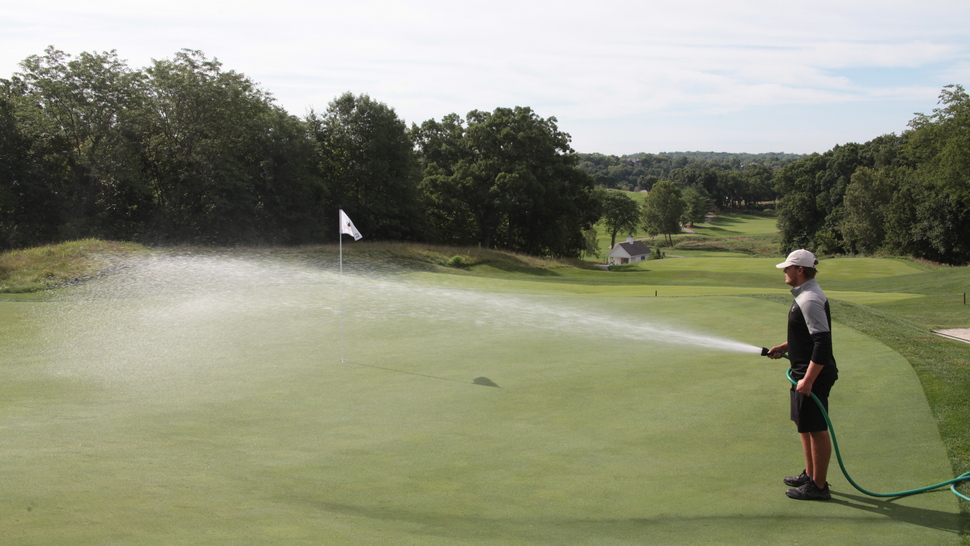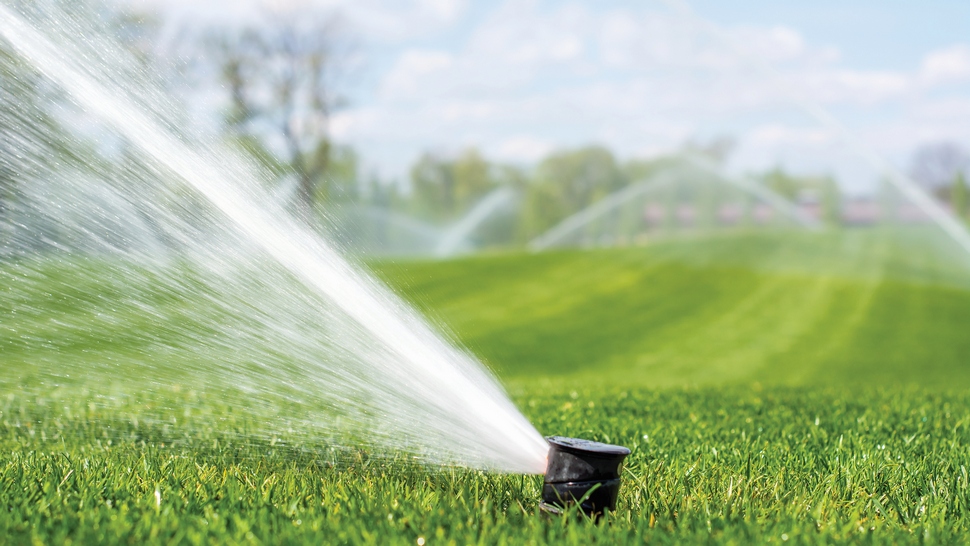The most stress producing position at any golf facility falls on the shoulders of those on the front lines — the superintendents at various golf properties. They are now the single most important people in shaping how the water usage debate will go forward from each individual golf property.
The superintendents will not only need to know the science involved but also manage the day-to-day public relations with golfers. Educating the understanding of golfers and shaping the ever-evolving debate is now front and center as a major element in any superintendent’s job description.
A survey was conducted by the Golf Course Superintendents Association of America (GCSAA) and funded by the GCSAA Foundation as part of its Golf Course Environmental Profile program, which began in 2005.
The report found that U.S. golf facilities applied approximately 1.68 million acre-feet of water in 2020, a 29% reduction since 2005. Two-thirds of the reduction was likely a result of operational golf facilities applying water more efficiently.
The survey results from nearly 1,600 golf course superintendents were collected and independently analyzed by scientists Travis Shaddox, Ph.D., Bluegrass Art and Science LLC., and J. Bryan Unruh, Ph.D. University of Florida, and the National Golf Foundation (NGF), which published the findings for peer review before making the information public.
“Data from the 2021 water use benchmarking survey show that golf course superintendents continue to reduce water use at their facilities. The survey results indicate a 9% reduction in applied water since 2013, totaling a 29% reduction since the inaugural survey was conducted,” Unruh said. “Similarly, the median acre-feet per acre, a measure of water use efficiency, has improved by 23% since 2005.”
The most common sources of water, according to the report, were wells (32%) and lakes and ponds (23%). Less water was applied in 2020 from each water source than in 2005 except for recycled water, which accounted for 21% of water applied.

Golf course superintendents have also increased the use of best management practices (BMPs) that can lead to reductions in water usage. BMPs such as keeping turf drier, pruning tree roots, changing to a more drought-tolerant turfgrass, mulching landscape beds and increasing no-mow acres were significantly associated with reductions in applied water.
The study also provides data on average water use in the seven different agronomic regions of the country. Decreased water use was seen in every region. The greatest water use applied per acre happened in the Southwest and Upper West / Mountain – two regions with high average temperatures and low average rainfall.
“Golf course superintendents are responsible stewards of water resources, and the latest national survey results demonstrate that,” said Rhett Evans, CEO of GCSAA. “Superintendents are committed to efficient water management and have implemented evidence-based best management practices that result in reduced water use. All golf facilities should maintain a BMP manual and strive for continuous improvement as water management plans are an important aspect of BMPs and overall environmental sustainability.”
Four leading superintendents were contacted to provide comments on this critical topic and to assess what lies ahead in this ever challenging and serious issue.
Water is clearly the oil of the 21st century.
The past days of unchecked water usage are now in the rear-view mirror. The broader golf industry will now face increased scrutiny and be judged by even more stringent regulations.
Cutting back on water usage has been achieved at a certain level now but the likelihood of additional future roll backs means even more pressures to comply.
The sustainability of golf rests firmly on the overall debate now happening within the sport.
The stakes involved are indeed that high.
***
Give a letter grade on the awareness level of your fellow superintendents in regards to the critical nature of how water is used in their daily efforts?
Roby Robertson: I would give my fellow superintendents in Texas a solid “A” for water usage in Texas. Outside of courses that utilize effluent sources, many Texas facilities utilize; Well water, surface water or public water sources, all come with stiff restrictions for quality and conservation.
Brian Dearstine: A.
John Hoyle: A.
Brian Boyer : Two grades here. B+ if you’re talking about how water is used in daily efforts to produce ideal playing conditions. No one wants winter rules in the summer.
If you’re talking about how water is used in daily efforts towards water conservation — C. Superintendents are directed by members and owners to provide visually appealing golf courses. All the better if you can do that while conserving water, but if not —
How well do you believe your respective clientele is aware of the need to conserve water and have steps been implemented to do so?
John Hoyle: Here we have members that understand that we have to be very aware of our water use, why we have completed projects to use less water, etc. But there are other members who want us to use more water and have a greener golf course during the summer months.
It’s our job as the Superintendent to continue to educate our members on this topic.
Brian Dearstine: I think most of our clientele that are familiar with our property and in the area would be aware of the conservation efforts mainly because of the recent renovation to the course.
Being county owned the government invested in the course as well as awareness to the area of what the project was trying to accomplish which was a course to aid in wildlife habitat and stormwater restoration as well as building an improved golf course.
Brian Boyer : It’s surprisingly 50/50 in our area. We have fliers around the buildings and we have links to our water district’s water conservation web page throughout our own website. Some of us have that same link in our email signature.
Roby Robertson: Clientele is aware of water concerns in our area mainly due to constant drought conditions and water suppliers’ inactions water cause restrictions a good portion of the year. The difference is depending on the supplier, the level of restrictions can be different and causes confusion.
Golf courses everywhere face the risk of drought and the problems that come with extended periods of dry weather. @USGAGrnSection agronomists are working hard to help courses deal with serious drought issues and water conservation strategies. pic.twitter.com/BDAqChRf78
— USGA (@USGA) September 17, 2021
Have you created an information newsletter or other source of info connection in which you provide updates and explain your efforts?
Roby Robertson: Yes, we utilize a weekly email blast here at TPC San Antonio to discuss activities at the club, I utilize my section to spotlight maintenance activities that also includes water use.
Brian Dearstine: Since starting in March, I have not had the chance to get anything started for a newsletter but use social media to communicate on course conditions and any projects going on at the course.
John Hoyle: I have educated the Golf Committee and Board members on our water restrictions and have answered other members questions on the topic.
Brian Boyer : No.
If so — what feedback have you received?
Brian Dearstine: Limited feedback but still positive from the ones who answer.
Brian Boyer : Since we don’t have an information newsletter or other information source there’s no feedback.
John Hoyle: Most members are very understanding.
Roby Robertson: Many members are surprised that our facility utilizes such a stringent Environmental plan that is highly focused on Water use and quality.
From a dollar standpoint — how much have you saved on water usage from say five years ago to present time?
Roby Robertson: The savings from water use has been measured more by efficiency percentage than by dollars. We have a very limited amount of water for irrigation and the proper use of water has been our focus rather than cost. In turn, more efficiency leads to more savings. In the area of monetary savings, keeping leaks to a minimum is a source of savings.
Brian Boyer : Had rates remained the same, we would have saved $44,000 annually. Rate increases have surpassed our conservation efforts.
Brian Dearstine: Being in the Mid-Atlantic I have not seen a huge difference in savings mainly because in the summer we are usually hot and humid, so water management has always been a focal point because of the disease pressure.
I think the main savings would be having more efficient irrigation heads that can run for less time as well as getting the water to where you need it, saving on electricity and wear and tear on the sprinkler system in the long run.
John Hoyle: We don’t pay for water, so nothing except for a little saving in electric for pumping the water.
Do you see it possible that environmental groups can see the benefit in what golf courses do or is the gap just too far to breach?
Brian Boyer : I won’t say it’s impossible, but it will be very difficult. Even if we show them our conservation efforts, the usage number still seems large to them. If they do get an understanding of our conservation, the discussion will then become something else like pesticide use or how golf is perceived to be a rich privileged sport.
Roby Robertson: I haven’t witnessed any recognition from environmental groups in relation to golf course water usage. I think the overall picture with environmental groups is more focused on the use of plant protectants and the water use and quality gets overshadowed.
I don’t see this the gap is too far to breach, but it is an uphill battle convinces some groups that we are leaders in conservation and environmental sensitivity, including water use and plant protectants.
Brian Dearstine: I think with more exposure and awareness of how golf courses operate, environmental groups will be able to see the benefits golf courses bring. I think the main issue with everyone is the number of pesticides used even though most of them are concentrated on the greens which for us is 3 acres of the 200-acre property.
While chemical usage could be harmful if used incorrectly, there is yearly training and certifications that ensure qualified personnel are making the applications. If the majority can look past the chemical inputs needed for the higher maintained turf than they would see the benefits to the environment and wildlife.
John Hoyle: I feel environmental groups can see the benefits in golf courses. I feel they are impressed by our organization and awareness when they come to our facility.
Our expanded relationship with Pebble Beach includes a joint initiative with the @USGAGrnSection to invest in turfgrass and water conservation research, contributing to our shared goal of creating enjoyable golf experiences that are environmentally sustainable. #EarthMonth
— USGA (@USGA) April 21, 2022
What kind of interaction do you have with environmental groups in your area of the USA?
John Hoyle: We have to report and communicate with the New York State Department of Environmental Conservation (NYDEC) and the Susquehanna River Basin Commission.
Brian Dearstine: The Preserve at Eisenhower is located just east of the Chesapeake Bay, so our water runoff flows directly into the bay. Since we are so close as well as being county owned the renovation project works with the Department of Natural Resources and Environmental Quality Resources to address drainage and stream restoration to help filter other water runoff that flows through our property’s streams and ponds before ending up in the bay. We also coordinate with the same agencies on selecting different varieties of pollinator plants as well as eradicating invasive plant species.
Brian Boyer : No scheduled interactions at this moment.
Roby Robertson: Most of my interactions has been with Environmental Specialists that are employed by the San Antonio Water System (SAWS). SAWS monitors our Environmental Management Plan and is a partner in our efforts to maintain water quality and conservation. We team with SAWS to regularly test water quality for any contaminates within our community watershed.
Drought emergencies may be declared by governmental agencies in the near future — if mandated to cut water usage by 50% could you do so and what would the ramifications be for your respective facility?
Roby Robertson: Our facility has been adjusting to water restrictions for many years. We are currently operating at 35-40% reductions due to drought. If we had to move to 50%, I think we would have to adjust our overall amount of irrigated turf, that is already at a set limit. Implications would lead to less overseeding, more natural areas and probably less landscaping.
John Hoyle: I think our fairways could handle being cut by 50%. We would have to change the way we water and put more emphasis on greens and less on tees and roughs.
Brian Dearstine: I think if a 50% reduction were needed for our property than we would be able to get by with only focusing on our greens and letting the other areas go dormant. I think the ramifications would be a reduction in play but the golfers at our course have been pretty understanding with weather related injury to the course whether it be too much rain or not enough.
Brian Boyer : Absolutely. Our playable surface area would shrink even further.
If you could change one thing in the golf / turf area you work in — what would it be and why?
John Hoyle: I would like to renovate some of the other areas on our golf course like we did to our fairways so that water usage on these areas could be reduced as well.
Brian Boyer : Have all the golf courses operating under one set of regulations when it comes to water use. Of the 20+ courses in our county, we have 5 different sources of irrigation water and 13 different water retailers that all have different regulations — all generally more restrictive than the state regulations.
Brian Dearstine: I think the main thing that I would change is the golfer wanting to see green grass everywhere. I know it looks great but from a player’s perspective firmer conditions always play better and to do that less water is needed which may cause some injury to the turf but there is no issue with playability.
Roby Robertson: In relation to water use, I would continue to attempt to convince people that are not associated with golf, that the stigma that golf courses are water wasters and heavy users is false and we monitor and manage our water sources with the upmost care and concern for quality and conservation.
https://twitter.com/USGAGrnSection/status/1570032867958136832?ref_src=twsrc%5Etfw%7Ctwcamp%5Etweetembed%7Ctwterm%5E1570032867958136832%7Ctwgr%5E12f99db05447f1233134fe9635ed4fb3eb70b35a%7Ctwcon%5Es1_c10&ref_url=https%3A%2F%2Fpublish.twitter.com%2F%3Fquery%3Dhttps3A2F2Ftwitter.com2FUSGAGrnSection2Fstatus2F1570032867958136832widget%3DTweet
Can golf fundamentally survive in the years ahead with expanded water restrictions and what core elements do you believe need to be done to prepare now for the future just ahead?
Brian Boyer : Yes. Community education as to what golf provides environmentally and the benefits it provides for that community. Also change the definition of what are good golfing conditions.
Roby Robertson: I do think golf will survive even with more stringent restrictions. I also think that as an industry we are already working towards that realization and have been for many years. The use of computer-controlled irrigation systems, water measuring devices becoming a daily requirement for managing water use and plant protectant suppliers and grass breeders joining in on the creation of products that are focused on reducing water use and impacts of that ideal.
Golf course superintendents are a tough group and we are faced with many adversities every day in the management of our facilities.
Brian Dearstine: I think if the golfers would lower expectations even a little since they are so high right now than golf will do fine. Golf’s popularity has grown in recent years so everyone expects better playing conditions with higher fees and revenue but with increased play there is more upkeep and wear and tear on the course so finding time to repair certain areas is also a challenge with so much play.
The way to prepare for that is communicate with golfers and try to get them to understand that there will be restrictions and certain areas may be neglected since they are less of a priority than others.
John Hoyle: I think golf can survive with water restrictions with the research that is happening with improved grass cultivars. But there will also have to great communication to the golfing community that certain areas of the golf course may not be as green as the past.
Pictures courtesy GCSAA
***
Sustainability Series
Part 1 – Debate growing – questions abound — answers needed
Part 2 – Debate growing – questions abound — answers needed
Part 3 – Innovative program bringing new golfers forward
Part 4 – “The Time Factor”
Part 5 – Water watch worrisome Pt.1
Part 6 – J. Bryan Unruh, Institute of Food & Agricultural Science,
Part 7 – Repurposing facilities, Minnesota’s momentum
The Participants
Brian Dearstine
Superintendent
Preserve at Eisenhower
Crownsville, Maryland
I have been working on a golf course from low end to high end private for 17 years now and just recently started my second superintendent job in the spring. I have been involved in two course renovations where new irrigation systems were installed making them more efficient as well as getting water to the needed areas providing less waste. My most recent course just went through a renovation and averages 200 rounds a day in season so learning what areas still need improvement as well as finishing up some tasks that were not completed during construction.
In 2008 Maryland had an extended drought so there were water restrictions put in place so any excess could be subject to fines. What we would focus on is keeping the greens and tees alive since those were bentgrass as well as the higher traffic areas. Watering the rough would be more of a challenge since they would use more water as well as being a high traffic course so while they would get watered it just would not be as much as needed.
Since the fairways were bermudagrass they would not need as much water, but the system was an older double row set up so would get watered along with the roughs. Therefore, some courses are more efficient now since they have in and out irrigation heads that line the fairway so you can limit how much water goes onto a warm season grass or if grasses differ from fairway to rough.
Charles “Roby” Robertson, CGCS
Director Golf Course Maintenance Operations
TPC San Antonio
San Antonio, Texas
I have been with the PGA Tour for almost 16 years and a golf course superintendent for over 30 years. I have had the pleasure of working in the Golf Course Business for over 40 years, I can’t recall a year without discussing water quality, conservation and/or usage.
Water conservation and water quality are in the forefront on a daily basis at TPC San Antonio. The entire project was based on water from conception and is a large portion of our Environmental Management Plan. TPC San Antonio is considered a “closed loop” system, there is zero water discharged from our property.
All rainfall and irrigation is captured in the existing sand capping and piped to retention ponds for future irrigation use.
John Hoyle, CGCS
Superintendent
Corning Country Club
Corning, New York
I have been the Superintendent at Corning Country Club for seven years. During that time, we have completed a fairway renovation. This renovation project included changing the grass on the fairways to an updated variety needing less inputs — including water.
Here at Corning Country Club, I am required to report water usage to two different government agencies. We are also held accountable to stay under a particular amount of usage by one of those agencies.
Educating our members on the amount of water we use to prepare the playing conditions here is one of the challenges. We have completed a project that changed the grasses on our fairways to a newer grass variety that uses less water. This project and new grasses provide great playing conditions while helping us stay under the amount of water we are allowed to use.
Brian Boyer
Golf Course Superintendent
Cinnabar Hills Golf Club
San Jose, California
I’ve been the Golf Course Superintendent at Cinnabar Hills Golf Club for the past 17 years. I came to San Jose from Michigan and graduated from Michigan State University with a B.S. in Crop and Soil Sciences, specializing in Turfgrass Management. It wasn’t until the drought of 2013 when I became a responsible irrigator.
Looking back, I recall a phone call I received in February of 2014 from our water district, Valley Water. A person from the Operations unit told me they would be shutting off our water. With a chuckle, they had asked if we’d be able to continue operating. Valley Water provides our only source of irrigation water so the answer was no. Their reply — “Oh — well sorry.”
After describing the call to the ownership group, meetings were set with Valley Water staff and the GM and I began attending bimonthly public meetings at the water district. The GM and I joined the recycle water committee, water conservation and demand management committee, and the landscape committee.
We educated everyone on our operation, made investments in our irrigation and operations budget, and began a voluntarily monthly water usage report. We were allowed to continue using water as long as we met the county wide restrictions of 20% reduction.
In that time, Cinnabar Hills Golf Club has earned numerous awards for water conservation efforts.




